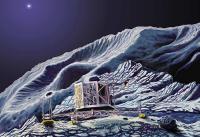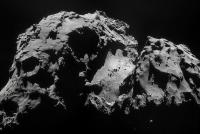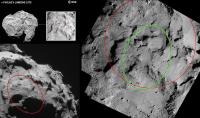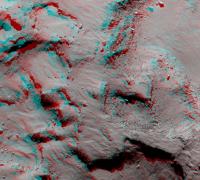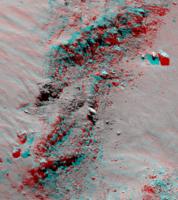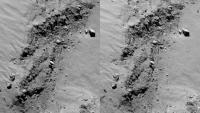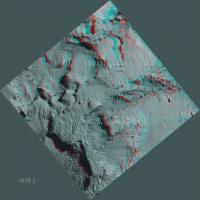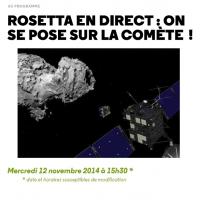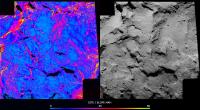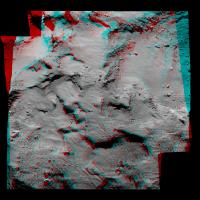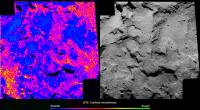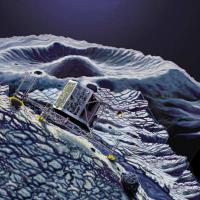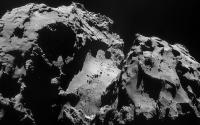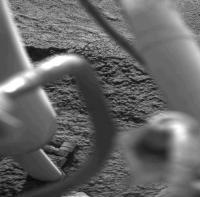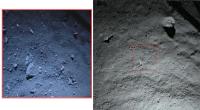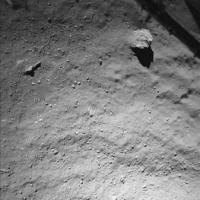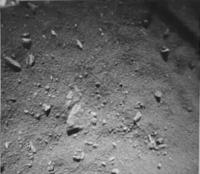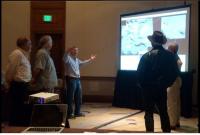Printable Version of Topic
Click here to view this topic in its original format
Unmanned Spaceflight.com _ Rosetta _ Philae landing on the nucleus of Comet 67P C-G
Posted by: vikingmars Sep 23 2014, 12:16 PM
Now, it's time to open a new section devoted to the landing of the Philae lander itself on the nucleus of Comet 67P C-G.
Also to answer better the earlier post,
http://www.unmannedspaceflight.com/index.php?s=&showtopic=7872&view=findpost&p=212943
and for your information, here is the quick summary (as a "pdf" file) of the events that are expected to occur during landing on the nucleus and after : it's the timeschedule on which we are working to set up our EPO event in Paris.
 Sequence_ATTERRISSAGE10_UMSF.pdf ( 263.81K )
: 4539
Sequence_ATTERRISSAGE10_UMSF.pdf ( 263.81K )
: 4539The landing itself should occur around November 11th.
We'll keep you informed
Posted by: SpaceScout Sep 23 2014, 02:14 PM
Great information, thank you!!
ROLIS will take nadir images all the way down from the separation to landing and I am sure the images will be of high scientific values, but as I am reading in the document, the images will be uplinked to Rosetta only after touchdown. Was there no way to transmit the images as quickly as possible, without waiting for the landing?
Posted by: Phil Stooke Sep 23 2014, 02:41 PM
The idea of transmitting images during the descent has been considered before, even as far back as the Surveyor landings on the Moon, and including Phoenix on Mars (actually, Phoenix MARDI images were not to be transmitted live, just transferred into the flight computer, and even that was too much of a risk).
Every time it has been abandoned because of the number and complexity of other operations at the same time.
Phil
Posted by: vikingmars Sep 23 2014, 03:40 PM
ROLIS will take nadir images all the way down from the separation to landing and I am sure the images will be of high scientific values, but as I am reading in the document, the images will be uplinked to Rosetta only after touchdown. Was there no way to transmit the images as quickly as possible, without waiting for the landing?
Dear SpaceScout, thank you for your kind comments.
Considering the great involvement of Germany in this mission, I should have put the timeschedule in German also, but my writing with Goethe's style is somewhat shaky : all my apologizes !
Yes, Phil is right : ESA does not want to interefere through the instructions with the transmitting of data during the landing phase. Sorry : so we will have to wait for the ROLIS images after a safe landing on the nucleus.
Posted by: Phil Stooke Sep 23 2014, 04:44 PM
I just realized that I forgot about Chang'E 3 in my comments above. We did have spectacular video of the descent and landing. But I realized - I don't know if that was transmitted during or after landing.
Phil
Posted by: Explorer1 Sep 23 2014, 05:51 PM
I think it was halfway; I recall the streamed images were received at a much lower rate then the final landing movie; either only some were released on the live stream or only some were transmitted during the sequence.
Ok, found it:
Here is the live stream recording:
https://www.youtube.com/watch?v=jyg56VIKRNA
And the 'complete' video:
https://www.youtube.com/watch?v=XNAGFTRvgDY
To not derail too far; what will be sent from Philae during the descent if not images; there will be some telemetry?
Posted by: SpaceScout Sep 23 2014, 06:00 PM
If I am getting this right, is the high number of processes that the computer needs to handle during descent (although is free fall) that prevent transmitting images ? Will Philae transmit live any telemetry at all to Rosetta before touchdown?
I am just thinking about the improvements that could be made for a next generation landing probe...
Posted by: MarsInMyLifetime Sep 23 2014, 06:15 PM
I am just thinking about the improvements that could be made for a next generation landing probe...
This is an interesting paper on the original conceptual design of Philae--from 1997! (just to remind ourselves of the era for which available stable technologies were being considered, and what incredible now-stable things might be in a next-gen lander)
http://www.open.ac.uk/personalpages/a.j.ball/publications/online/capcom.html
No descent imaging was even described in that paper, so the present capability and operational plan is a privilege, considering. Whole careers go by in the course of one such mission!
Posted by: djellison Sep 23 2014, 06:47 PM
I don't believe they'll be taking a lot of descent images....indeed, there's not much point. OSIRIS resolution will out-perform that of the descent imaging until we're pretty close to the surface. One before bettering OSIRIS res , one at some intermediate point, one just before touch-down.....that would be enough for a very good localization.
Posted by: vikingmars Sep 23 2014, 08:29 PM
Yes, Doug : indeed ! OSIRIS has a far better resolution than ROLIS from orbit.
This is why ROLIS will take just a few images during the descent. BUT at a low altitude (i.e. tens of meters from the surface) and until touchdown, it will start taking one image every 5 seconds...
Posted by: machi Sep 23 2014, 10:04 PM
Original plan was (and it looks still is) to take few images after release from Rosetta and then few images before landing.
"Few" means up to 8 images.
Posted by: Tom Tamlyn Sep 24 2014, 03:21 AM
Every time it has been abandoned because of the number and complexity of other operations at the same time.
Phil
The Ranger moon spacecraft perforce transmitted images during descent, because there wasn't any afterwards, but I can't think of any others. Well, maybe NEAR, if you call the whole approach a descent because the spacecraft eventually touched down, but that would be whimsical.
Can't think of any others, but of course I don't have the encyclopaedic recall of the two Dougs.
Posted by: Hungry4info Sep 24 2014, 03:42 AM
MSL did a whole descent movie. MER did a couple descent images if I recall right.
Edit: Nevermind. The discussion was about transmitting them during descent rather than storing and transmission later.
Posted by: Explorer1 Sep 24 2014, 03:47 AM
And don't forget Huygens!
It's true that discussing why Huygens transmitted pictures on the way down and Philae won't is comparing apples and oranges (one had atmospheric observations as the primary objective with landing as a bonus, while the other is exclusively a lander), but there is a precedent of descent imaging from ESA.
Posted by: Hungry4info Sep 24 2014, 03:51 AM
Was there anything similar planned for Beagle 2?
Posted by: MarsInMyLifetime Sep 24 2014, 04:11 AM
Beagle's airbag-wrapped landing process precluded the need for descent imaging. But this discussion is drifting from the subject of Philae itself. Philae will be a free-falling object without the ability to use the descent images for terrain avoidance; figuring out where it landed after the fact is much more important, so deferred imaging is fine. The issue is less about precedents than about requirements for the mission, with science and engineering both as stakeholders in the outcome.
Posted by: Explorer1 Sep 24 2014, 04:20 AM
A big difference from Beagle 2 is that OSIRIS will be able to resolve Philae on the surface right away, so even loss of contact would be a learning experience. This will not be a shot in the dark.
Posted by: SpaceScout Sep 24 2014, 03:37 PM
and I think this is the most important point. Whatever happen to the lander, it will be possible to reconstruct its approach and touchdown.
Posted by: Phil Stooke Sep 24 2014, 05:37 PM
One aspect of landing which I don't think has been mentioned is that it takes 7 hours for the lander to descend from release to the surface. That's over half a rotation. So it's not like hovering over the landing site and letting go - the landing site is far away, and as the lander falls the landing site moves until, at the appointed time, it's just under the lander. Like one of those action movies where somebody jumps off a bridge to land on the top of the train car as it passes underneath ... only a bit slower. It's easy to see that any uncertainty in the descent rate translates into a change in location on the surface.
Phil
Posted by: vikingmars Sep 24 2014, 06:12 PM
Well seen Phil ! This is not a descent, but a low-speed free-fall, hoping that the lander will not gain too much horizontal velocity at touchdown...
PS : the 7 hrs descent, from "T0" to "T0 + 7h", was duly mentioned inside the "PDF" timetable attached to the 1st post
Posted by: centsworth_II Sep 24 2014, 06:51 PM
I'm wondering what percent of Phillae's descent rate is due to the mechanical push toward the comet it receives and how much is due to gravity and how that changes over the course of the descent. Has this been described?
Edit: After some more reading and thought, I've concluded that the mechanical shove is almost entirely devoted to counteracting orbital velocity (and not to push the lander toward the comet) and that the descent is pretty much 100% due to gravity.
Posted by: charborob Sep 24 2014, 07:49 PM
Is there an animation somewhere that shows the complete Philae landing sequence, including the comet rotating in the background? From the descriptions I read, I can't figure out how exactly it's going to work out.
Posted by: Gerald Sep 24 2014, 08:42 PM
Far from competing with Goethe (I'm sure he would be excited by the mission), here my amateur translation of your appreciated survey into German:
 philae_landing_schedule_de_utf8.txt ( 2.96K )
: 1314
philae_landing_schedule_de_utf8.txt ( 2.96K )
: 1314Posted by: MahFL Sep 25 2014, 12:08 AM
Yes, it's at 12:40 on this presentation, the comet actually hits the lander, albeit softly. If they did not have the hold down thruster, the harpoons and screws on the legs the lander would bounce away from the comet.
http://www.esa.int/spaceinvideos/Videos/2014/09/Replay_Rosetta_landing_site_announcement
Posted by: charborob Sep 25 2014, 03:11 AM
That's exactly what I wanted to see. Thanks. Unfortunately, I didn't have the time to watch the presentation.
Posted by: vikingmars Sep 25 2014, 07:12 AM
 philae_landing_schedule_de_utf8.txt ( 2.96K )
: 1314
philae_landing_schedule_de_utf8.txt ( 2.96K )
: 1314Thanks a lot Gerald for this nice work !
I keep the German translation in my records.
We may have also some German visitors in Cite des Sciences in Paris and they may like some documentation in German too (I'll put your name as translator then)...
"Goethe mit uns"
Posted by: TheAnt Sep 26 2014, 01:09 AM
Landing site J with C as backup if they spot anything untoward on the first selection.'
(Edit: Since I heard it verbally I got it wrong still think they really said 'G'.)
Posted by: vikingmars Sep 26 2014, 03:14 PM
A new set of 2 Rosetta NavCam images was released this afternoon by the Rosetta team... (sorry, again, no OSIRIS images).
This NavCam image is a very interesting one : it shows the backup "C" landing ellipse (see the superimposed yellow ellipse I draw on the left-hand side of the image)...
Wow ! Look carefully at it : its the only "safe" place around, among truly chaotic terrain ! What a GREAT mission indeed ![]()
Posted by: Gerald Sep 26 2014, 10:28 PM
http://www.esa.int/Our_Activities/Space_Science/Rosetta/Rosetta_to_deploy_lander_on_12_November :
For the primary landing scenario, targeting Site J, Rosetta will release Philae at 08:35 GMT/09:35 CET at a distance of 22.5 km from the centre of the comet, landing about seven hours later. The one-way signal travel time between Rosetta and Earth on 12 November is 28 minutes 20 seconds, meaning that confirmation of the landing will arrive at Earth ground stations at around 16:00 GMT/17:00 CET.
If a decision is made to use the backup Site C, separation will occur at 13:04 GMT/14:04 CET, 12.5 km from the centre of the comet. Landing will occur about four hours later, with confirmation on Earth at around 17:30 GMT/18:30 CET. The timings are subject to uncertainties of several minutes.
The 22.5 km look rather distant. I'm not quite sure about the reason. Might be it turned out, that Philae is more predictable than Rosetta regarding drag due to outgassing? Or it has something to do with the observability of Philae during the descent and communication early after landing.
Posted by: MahFL Sep 26 2014, 11:10 PM
Remember you do not want the orbiter to accidentally hit the comet too, so someone decided 22.5 km was the distance to use.
Posted by: MarsInMyLifetime Sep 27 2014, 01:54 AM
The latest NavCam composite shows that the left (main lobe) side of the valley seems to have cliffs with deep shadows, possibly vents. Now, seeing the line of boulders in the valley, I have a more distinct impression of gases from both sides of the valley impinging in the middle, creating on one hand a zone of stagnated velocities in which levitated boulders could lose escape velocity and drop down along that preferential zone, and on the other hand forming a plane of converged gas and dust. That plane would appear like a jet along the zone of impingement, and appear diffuse when viewed away from that plane. Just a thought, but it could explain why single sources for the "jets" have not been clearly identified yet, and why they appear variable based on direction.
Posted by: Phil Stooke Sep 27 2014, 03:12 AM
That idea of jets forming where two or more broad cones of emission meet, channeling dust into sheets (two cones) or collimated jets (three cones) was referred to earlier in our discussions and originated with Jean Crifo 20 years ago (Icarus, 1995, v. 116, pp. 77-112).
Phil
Posted by: MarsInMyLifetime Sep 27 2014, 04:28 AM
Thanks for the reminder, Phil. All very easy to visualize now.
Posted by: Paolo Oct 15 2014, 01:19 PM
Site J confirmed as the landing site: http://www.esa.int/Our_Activities/Space_Science/Rosetta/ESA_confirms_the_primary_landing_site_for_Rosetta
and we are given http://www.esa.int/spaceinimages/Images/2014/10/Philae_s_primary_landing_site_from_30_km. (ADMIN EDIT) ![]()
Posted by: MahFL Oct 15 2014, 01:44 PM
It's not exactly flat is it ?
Those cliffs have to be at least 20 feet high ?
Posted by: centsworth_II Oct 15 2014, 03:56 PM
On the left, the original ESA landing oval in white and my red ovals on the other two images. On the right, ESA's red circle marking landing site J on the latest image (rotated) with my green oval marking where I think the original ESA white oval would be located.
Posted by: fredk Oct 15 2014, 06:15 PM
It's not clear these are landing error ellipses, since I couldn't see any such description in the captions of either image. The caption of the latest image just says
The cross marking the central landing position in the old image is pretty close (but not exactly) at the centre of the new red circle. There's no way to know if that's just plotting error or a slight adjustment in the central position.
Posted by: SpaceScout Oct 16 2014, 07:42 AM
I have not seen this very high close up of the landing site J posted here, so here http://www.esa.int/var/esa/storage/images/esa_multimedia/images/2014/10/philae_s_primary_landing_site_from_30_km/14971370-1-eng-GB/Philae_s_primary_landing_site_from_30_km.jpg. Many wonderful details! thank you ESA
Posted by: Phil Stooke Oct 16 2014, 11:32 AM
http://blogs.esa.int/rosetta/2014/10/16/landing-sites-from-30-km/
The individual images for the Osiris mosaic of the landing area are here, plus - very nice - two images for site C as well.
Phil
Posted by: fredk Oct 16 2014, 02:49 PM
Primary landing site in anaglyph stereo. There are severe distortions here and I've only done a quick a dirty job aligning the frames, so this may be headache-inducing:
Posted by: fredk Oct 16 2014, 03:06 PM
And a better-aligned crop of a scarp, showing precariously perched boulders/protrusions that couldn't exist in Earth-like gravity. Anaglyph:
Cross-eyed:
Posted by: climber Oct 16 2014, 03:25 PM
I'm wondering how far we'll see once on the ground. If we were to land on a perfectly flat surface, horizon would be very very close I believe, but on THIS, it's hard to predict anything.
Posted by: jhagen Oct 17 2014, 07:15 AM
The individual images for the Osiris mosaic of the landing area are here, plus - very nice - two images for site C as well.
Phil
Here's my version of a site J anaglyph...
Posted by: MahFL Oct 17 2014, 11:15 AM
If we see something, it's going to be awesome. I would guess the horizon would be 300 meters away or so. The jets though should be something else.
Posted by: katodomo Oct 17 2014, 05:28 PM
More so because the CIVA-P cameras are mounted tilted 15 degrees downwards.
Posted by: vikingmars Oct 25 2014, 10:17 AM
For those interested to attend this historic landing and take this opportunity to fly to Paris (and pay us a visit : TPS / UMSF Members, please, tell us in advance), here below is the link to the only other official ESA/CNES event set-up for the landing of Philae (with the one held in ESOC in Darmstadt).
As you may know, the engineering of the Philae lander is under the responsibility of CNES (the French Space Agency), as well as its CIVA cameras and instruments suite.
This event will take place at the National Science Museum (Cite des Sciences) in Paris :
http://www.cite-sciences.fr/fr/au-programme/activites-spectacles/conferences/thema-a-la-recherche-du-temps/evenement-rosetta-en-direct-on-se-pose-sur-la-comete/
...and thanks again for your kind support over all those nice comments and posts !
Enjoy !
PS : Societe Astronomique de France is the partner of TPS in France since 1982
Posted by: polaris Oct 25 2014, 12:48 PM
Bonjour Olivier !
Faut-il s'inscrire ?
Même s'il faut attendre pour y participer, j'y serai !
Cdt
Posted by: vikingmars Oct 25 2014, 11:10 PM
Même s'il faut attendre pour y participer, j'y serai ! Cdt
Thanks a lot, Polaris
Please, try to arrive at 14:00 at the latest... And name you : I'll try to arrange so that you are well seated ! Friendly yours, VM
Posted by: mcgyver Oct 28 2014, 02:24 PM
Every time it has been abandoned because of the number and complexity of other operations at the same time.
Why can't they just use a separated and standalone camera to take snapshots during landing? If it works, that's fine, else, who cares?
Is there a detailed 3d model of the landing site available for 3d printing? I already printed the comet model, but the landing site detailed 3d model would fit well close to it on my desktop. :-)
Posted by: djellison Oct 28 2014, 02:27 PM
They do. The challenge is offloading the data thru the flight computer to be transmitted back up to Rosetta and from there on to Earth - all whilst the flight computer is trying to land.
Posted by: mcgyver Oct 28 2014, 02:44 PM
This remembers me of the https://www.hq.nasa.gov/alsj/a11/a11.1201-pa.html.
Anyways it's really incredible to see how electronics evolved during mission journey!
Posted by: dvandorn Oct 28 2014, 03:22 PM
As Curiosity demonstrated, though, it is quite possible (with modern electronics) to take descent images, store them and send them back to Earth later, when the landing sequence is *not* making the lander too busy to add the image transmission to its duties.
I would hope that planetary landers from now into the future will have this capability. It's not just valuable for developing context of the landing site within the general area, it also has the highest "cool factor" of any part of the missions, IMHO.
-the other Doug (With my shield, not yet upon it)
Posted by: mcgyver Oct 28 2014, 04:05 PM
What I really hope/expect from future missions is HD video-shooting capability, rather than 1 Frame Per DAY "videos"
What was available on the (space) market in 1993 (date of mission acceptance) for onboard processing power and data storage? 10 MHz and 10 MB?
Posted by: djellison Oct 28 2014, 04:36 PM
There's a few issues with what you're saying. Firstly - Rosetta is taking a lot lot more than 1 frame per day..... that's simply what's being released at the moment. Once all this data is delivered to ESA's PSA - there will be hundreds of image of 67P that people will be able to turn into pretty amazing animations.
And who cares how long it might take to downlink an HD video? Well actually - all the scientists and engineers entrusted with operating Rosetta and doing science with it. The amount of data it's possible to return from the somewhere as far as 67P is a massive constraint on operations. It's not a question of taking an HD camera, or processing it's data...it's getting it back to Earth.
A rough calculation: 90 second of highly compressed 720p video is around 170 Megabytes. At typical data rates from Rosetta - that would take 8 HOURS to download from the spacecraft. That represents pretty much an entire day's downlink from a typical deep space spacecraft. And for what? An HD video 90 seconds long that, to be honest, would be better represented by a few 2k x 2k still images anyway - and you would have given up all the other scientific measurements Rosetta could take that day. These spacecraft do not last for ever. It's wrong to assume data will somehow magically make it to Earth eventually.
Curiosity is capable of, and indeed has taken HD video from the surface of Mars - but only on a few very specific, very select and very rare occasions, for the same reasons - the quantity of data it's possible to return from deep space is a massive, massive constraint. Kaguya at lunar distances was capable of, and indeed did return many HD movies of the moon where the data rate doesn't represent such a constraint ( typical downlink from lunar orbit is more than 2,000 times faster than Rosetta right now.
Posted by: polaris Oct 28 2014, 06:02 PM
Many thanks, Olivier !
I'll be there, right in time !
Posted by: Malmer Oct 29 2014, 12:44 AM
I made a slopemap of site J using my terrain-model. (I'm assuming that the center of rotation is the gravityvector for the surface)
Cyan=good
Red=bad
Posted by: SpaceScout Oct 29 2014, 09:13 AM
Red=bad
Great work! It looks promising for Philae. Can you tell us how much percent represent the "cyan=good" (<few degree) area?
Posted by: DDAVIS Oct 29 2014, 09:50 AM
'An HD video 90 seconds long that, to be honest, would be better represented by a few 2k x 2k still images anyway'
There may well be dynamics that only video will show, something to keep in mind for a future comet probe. I think of water dumps from old live feeds on NASA TV.
'Curiosity is capable of, and indeed has taken HD video from the surface of Mars - but only on a few very specific, very select and very rare occasions, for the same reasons'
It seems a waste to have capability that isn't used.
I wonder what the minimum time between 'RGB' filtered frames is for Rosetta? If the interval is brief enough there should be color images of the comet. They can eventually be used to help add color to lander images.
Posted by: Malmer Oct 29 2014, 10:13 AM
Another surface feature map I made to try to understand the obstacles Philae faces.
I have no real unit for surface roughness. (is there one?) but it is clear that you want to land in the blue areas.
Posted by: mcgyver Oct 29 2014, 10:15 AM
I'd like to make an elevation map, but I can't find any suitable free program. I tried a couple of "disparity map generators", but I get ugly results...
DMAG, StereoPlus... what else could I use?
I already 3d-printed the whole comet, now I'd like to 3d-print the landing site too, before landing happens!
Posted by: Malmer Oct 29 2014, 10:30 AM
DMAG, StereoPlus... what else could I use?
I already 3d-printed the whole comet, now I'd like to 3d-print the landing site too, before landing happens!
You have to have a resonable disparity generator. preferrably one that understands the two cameras orientation in respect to eachother. (or you will have to bring the pictures into alignment with some other software.) then you will have to tweak and tweak until you have the best possible settings. Then you will probably get something that is resonably ok on a mid to global scale. there will still be local noise. To combat that I would suggest that you use shape from shading to capture the fine details.
Posted by: vikingmars Oct 29 2014, 10:31 AM
Cyan=good
Red=bad
Thanks a lot Mattias for this very, very good work of yours !
If fact, we are not on Mars and there is not such a big number of 'bad' slopes, because in such a low-gravity object, we may 'land' in an hi-degree slope and stay there without sliding 'downwards', because we will screw into it.
On the other hand, and because of such an eventuality, there is a strong possibility that the CIVA panorama looks very, very tilted with little horizon to be seen. Anyway, the horizon is so close that most of the interest of the CIVA images is in the looking 'downwards' to see tiny ground features around the lander that may sublimate/evaporate/move as we are closing to the Sun...
Posted by: Malmer Oct 29 2014, 12:29 PM
If fact, we are not on Mars and there is not such a big number of 'bad' slopes, because in such a low-gravity object, we may 'land' in an hi-degree slope and stay there without sliding 'downwards', because we will screw into it.
On the other hand, and because of such an eventuality, there is a strong possibility that the CIVA panorama looks very, very tilted with little horizon to be seen. Anyway, the horizon is so close that most of the interest of the CIVA images is in the looking 'downwards' to see tiny ground features around the lander that may sublimate/evaporate/move as we are closing to the Sun...
Happy to be of service!
I'm more worried about the rough boulder fields. I think those are more troublesome than just a slope.
But it is hard for me to really say much about. I would like the 10Km OSIRIS look of the area.
I made my roughness map to get a feel for the different areas.
Thankfully there is a lot of blue there. (and landing in a red area could with some luck work just as well)
Posted by: Gerald Oct 29 2014, 12:34 PM
There are several measures of http://en.wikipedia.org/wiki/Surface_roughness, most of them related to the usual statistical techniques to describe a distribution. It's mostly about amplitudes in a hipass version of a DTM, or by applying the shape by shading philosophy and assuming constant albedo, about amplitudes of the brightness in a hipass version of the greyscale image.
Dimension will be length in many cases, unit in meters, e.g. for the standard deviation; for variance it would be square meters.
You could now correlate those surface roughness values with probabilities for successful landings, to provide a probability map of successful landing constrained to the surface roughness aspect.
Adding slope etc. to a simulation of landings could provide an overall probability map for successful landing with http://en.wikipedia.org/wiki/Monte_Carlo_method as the underlying principle.
Besides geometric surface properties, the consistence of the material will play a key role for successful anchoring.
Posted by: vikingmars Oct 29 2014, 01:04 PM
I'm more worried about the rough boulder fields.
Absolutely agree with you Mattias.
The big boulders are of a real concern, because :
- they may made the lander touch them and flip over upon arrival ;
- the lander may not be able to screw into them ;
- the lander body may land on the very top of a boulder (big or small) and its landing mechanism may not be able to fold down enough on its sides to get a grip on it and/or the soil...
It's really going to be a tough landing anyway !
Posted by: mcgyver Oct 29 2014, 01:12 PM
Isn't an anaglyph enough? It is already aligned and I can extract images from it with StereoPhotoMaker.
http://www.esa.int/var/esa/storage/images/esa_multimedia/images/2014/09/philae_s_primary_landing_site_in_3d/14819862-1-eng-GB/Philae_s_primary_landing_site_in_3D_node_full_image_2.png
Posted by: mcgyver Oct 29 2014, 01:15 PM
Is it available to the public?
Posted by: blake Oct 29 2014, 01:47 PM
Questions from an interested non-expert:
I have read that Philae may still partly function if it lands in the wrong orientation (lying on its side, or similar). Is there the possibility that Philae may bounce off the surface, or even not contact the surface? In either of these scenarios, would Philae still be able to transmit back whatever data or images it has already taken?
Is there a scenario other than spacecraft system failure where Philae would not be able to transmit data back (like landing upside down, perhaps)?
Thanks.
Posted by: vikingmars Oct 29 2014, 02:02 PM
I have read that Philae may still partly function if it lands in the wrong orientation (lying on its side, or similar). Is there the possibility that Philae may bounce off the surface, or even not contact the surface? In either of these scenarios, would Philae still be able to transmit back whatever data or images it has already taken?
Is there a scenario other than spacecraft system failure where Philae would not be able to transmit data back (like landing upside down, perhaps)?
Thanks.
Good question. The landing site is so chaotic...
Franckly we don't know : so mainy possibilities of failures and so many possibility of successes...
What is certain is that as soon as it touches the ground, the lander tries to screw its footpads into it and there is a small engine on top of it that pushes it downwards to maintain a contact as long as the grip is not firmy done...
We'll know for sure in what shape the lander is upon arrival on the 12th !
Hope for the best !
Posted by: Gerald Oct 29 2014, 04:09 PM
Is there a scenario other than spacecraft system failure where Philae would not be able to transmit data back (like landing upside down, perhaps)?
http://nssdc.gsfc.nasa.gov/nmc/spacecraftDisplay.do?id=PHILAE:
S-band communication usually is rather tolerant in terms of pointing.
Although I didn't find reliable information about whether the (two?) Philae S-band antennas (at least taken together) are omnidirectional.
The other instruments may shield the radio waves in some directions. But if Philae doesn't vanish in some deep gap, I'm optimistic, that communication will be possible in some directions, at least, as long as the batteries are charged.
Most descent data will be transmitted before touchdown; thus we'll get some infos of the descent phase, at least.
Posted by: fredk Oct 29 2014, 05:14 PM
What do you mean by "centre of rotation"? What point do you point the gravity vectors to?
I suppose that for these purposes, and without a mass distribution model, you could choose that point such that some average slope over the area of the plot is close to zero. Of course that may not be very accurately true.
Posted by: djellison Oct 29 2014, 05:42 PM
Whilst the lower frequencies are less fussy regarding pointing - the predominant factor in required pointing accuracy is antenna design - NOT frequency.
The S-Band relay from Huygens to Cassini had a beamwidth of only 2.3-2.4 degrees because it used Cassini's HGA.
http://descanso.jpl.nasa.gov/DPSummary/Descanso3--Cassini2.pdf ( page 8 )
Whereas Deep Impact's probe-flyby relay used S-Band but patch-antennas that were in essence omnidirectional and managed 64kbps downlink at 8,000km range.
Posted by: Hungry4info Oct 29 2014, 06:00 PM
Great new, close-up image of that smoothe area on the "bottom" of the larger lobe. Looks like they also give us a mosaic, too.
http://www.esa.int/spaceinimages/Images/2014/10/Comet_on_26_October_NavCam
Posted by: Explorer1 Oct 29 2014, 06:35 PM
If tweets are any evidence, we might be getting separation images from both Philae and Rosetta! I'm assuming it would be with NAVCAM? Osiris would be tough to focus that close...
https://twitter.com/ESA_Rosetta/status/527460959657689088
And some COSIMA results: http://blogs.esa.int/rosetta/2014/10/29/cosima-detects-sodium-and-magnesium-in-a-dust-grain-called-boris/
Posted by: Malmer Oct 29 2014, 08:56 PM
Thank you Gerald for all the good info!
http://www.esa.int/var/esa/storage/images/esa_multimedia/images/2014/09/philae_s_primary_landing_site_in_3d/14819862-1-eng-GB/Philae_s_primary_landing_site_in_3D_node_full_image_2.png
You can obviously build a disparity map from that image. (I made a shape-model of that very anaglyph a while back) but you will not know the actual height of anything unless you also know the camera positions. you get only relative heights.
you can download that old one from here if you like:
http://classic.syndicate.se/image/space/Landingsitemodel.zip
The new one is much better. I have the camera positions and all that good stuff reverse enginnered so it is an absolute map. (it matches my Global shapemodel) will post it when it is more finalized.
I suppose that for these purposes, and without a mass distribution model, you could choose that point such that some average slope over the area of the plot is close to zero. Of course that may not be very accurately true.
I'm simply aiming my gravity vector towards the center of mass of the comet (the point it is rotating around)
I did some simple tests with my global shape model. I fill it with particles and let them gravitationally affect an external point. At the top of the comet the gravity vector is pointing mostly towards the center of gravity of the comet anyway. There are areas in the neck area that have gravity vectors pointing slightly of to one side or the other but it is not by a huge deal. (I'm assuming a homogeneous comet with no mass concentrations because of lack of data) I also did not factor in the spinning. (to much math for one night)
I'm so excited about the landing. I really hope it works out well. There is so much science to be gained if it works as planned.
I made my maps to try to get a feel for the chances. I think it looks really promising. There are very few really steep slopes in the area. And there are big areas of very few boulders. (at the scale of this picture)
About those flat dust plains. Is there any reason to fear that the dust would be very soft and that the lander would just sink?
Posted by: ngunn Oct 29 2014, 09:21 PM
Sinking under its own weight is unlikely as it will weigh very little. (It could potentially dig itself in with its landing motor maybe?) I think a bigger problem might be attaching to dust with screws.
Posted by: djellison Oct 29 2014, 09:44 PM
It's not surface 'weight' that's the problem ( about 11 grams by my rough calculations - 0.01 Newtons )
It's the impact of landing. 1m/sec to a dead stop in, say, 20cm..... is a 5m/sec/sec deceleration - which is 500N of deceleration force for the 100kg Philae: 50,000x higher than the resting surface weight.
Posted by: Malmer Oct 29 2014, 11:04 PM
It's the impact of landing. 1m/sec to a dead stop in, say, 20cm..... is a 5m/sec/sec deceleration - which is 500N of deceleration force for the 100kg Philae: 50,000x higher than the resting surface weight.
...or in the words of xkcd:
http://xkcd.com/89/
Posted by: fredk Oct 30 2014, 02:05 AM
A body doesn't rotate around a point, it rotates about an axis. So you have to decide where on that axis your gravity vectors point to.
The centre of mass (COM) calculated assuming uniform density is probably a good first approximation to the gravitational field direction. It would be very interesting to see how close the uniform-density COM is to the rotation axis. That would tell you something about how good the uniform-density approximation is, since (I believe) the COM will lie on the rotation axis for a body that actually has uniform density.
Posted by: Norm Hartnett Oct 30 2014, 04:10 AM
Thank you for the wonderful image in http://www.unmannedspaceflight.com/index.php?s=&showtopic=7896&view=findpost&p=213418 vikingmars! With a bit of cropping and resizing I was able to make quite a dramatic wallpaper for my computer.
After staring at it for many days I realized that I was having a hard time grasping the scale of what I was looking at. I've spent some time looking at the scale of the many followup photos and came to the conclusion that the boulders(?) in the rift/conjunction valley(?) must be around 2 to 5 meters. Is this in the ballpark?
Posted by: centsworth_II Oct 30 2014, 05:17 AM
While awaiting more expert input, I would say the largest is about 20 meters.
Posted by: Malmer Oct 30 2014, 09:49 AM
Thats true, I stand corrected...
Anyway, I did not factor in rotation... so then the center of mass was the simplest point to choose.
I also did not calculate my own center of mass. I used the center of the coordinate system that ESA used for this VIRTIS map as my center of mass...
http://mattias.malmer.nu/wp-content/uploads/2014/10/VIRTIS_LAT_LONG.jpg
I will try to do a new map where I calculate the effects of rotation and local gravity. then I can do a dot product between the vectors and see if the difference is much to talk about... (the J site is almost on the equator so the rotation should not make all that much difference. J has most of the mass centered under it so the deflection of the gravity vector is not going to be too aggressive either.)
Interesting stuff...
Posted by: Y Bar Ranch Nov 1 2014, 04:15 PM
Actually, to be super-pedantic about it (sorry, can't resist) rotations are best considered occurring in a plane rather than around an axis. That is why you can have rotations in a 2D world (no third axis exists to rotate around) and it is how in a 4D world you actually have 6 potential "cardinal" rotations in planes rather than just 4 about axes. Just so happens in 3D that you get one orthogonal axis per plane.
Posted by: PhilHorzempa Nov 1 2014, 04:57 PM
I agree with Doug about the force of contact with the comet's surface.
It's the impact of landing. 1m/sec to a dead stop in, say, 20cm..... is a 5m/sec/sec deceleration - which is 500N of deceleration force for the 100kg Philae: 50,000x higher than the resting surface weight.
In fact, I predict that the Philae lander will sink out of sight.
In a paper by Schultz, et al, analyzing results of the Deep Impact mission, there is mention that the surface of Tempel 1 has a density of 0.2 - 0.5 g/cc, with a porosity of 90%!
Posted by: MahFL Nov 1 2014, 05:59 PM
In a paper by Schultz, et al, analyzing results of the Deep Impact mission, there is mention that the surface of Tempel 1 has a density of 0.2 - 0.5 g/cc, with a porosity of 90%!
Then how are house sized rocks sitting on the surface ?
Posted by: centsworth_II Nov 1 2014, 06:03 PM
Those "rocks" are probably not very dense. They may be more like big fluff balls, or maybe light but stiffer, like pumice.
Posted by: MahFL Nov 1 2014, 06:20 PM
The lander is not that dense and has three long legs to spread the weight.
Posted by: MahFL Nov 1 2014, 06:26 PM
Rosetta has been successfully moved to to the correct orbit for the landing.
Won't ever be as close to the comet again for the rest of the mission.
http://blogs.esa.int/rosetta/2014/10/31/rosetta-lined-up-for-lander-delivery/
Posted by: centsworth_II Nov 1 2014, 06:32 PM
I don't believe the lander will sink. Brilliant minds have been predicting sinkage ever since the first moon landings. I think the biggest risk would be in the neck of the comet, but in the actual landing area I get the sense that smooth areas have a solid underlayment. Lets hope the doomsayers are just as wrong as they were for the moon landings.
Posted by: PhilHorzempa Nov 1 2014, 07:55 PM
Just want to add some more details on why I think that Philae will sink "out of sight."
First, here is the link to the Schultz, et al, paper, "The Deep Impact oblique impact cratering experiment" -
http://www.planetary.brown.edu/pdfs/3589.pdf
In section 5, "Concluding remarks," there is reference to the low-density (0.2 - 0.5 g/cc) and highly porous (90%) surface of comet Tempel 1.
Here is a photo of one of Viking 1's footpads totally buried in a surface deposit -
This "burial"event occurred during the Viking landing. Similar "burials" have plagued the MER rovers on Mars.
These are examples of loosely consolidated, probably very-fine, particle piles. Even with a respectable gravity field, these Martian "traps" remain very porous.
In the case of comets, my guess is that some of the very fine particles expelled in gaseous jets fall back very slowly to the comet surface.
The extremely low gravity on a comet would mean that those accumulations of particles will remain very porous, with a very low density.
So, Tommy Gold may finally be vindicated, albeit not with respect to the Moon.
So, there is my prediction on the fate of Philae as it makes contact with the surface of Comet CG.
I may be wrong, but that is OK. Part of the business of science and exploration is the risk of predictions. I await the landing with anticipation.
Another Phil
Posted by: nprev Nov 1 2014, 08:02 PM
I think it's extremely unlikely--not only is the gravity extraordinarily weak, but the vector of same might not even be parallel to local vertical at the landing site--but we'll find out in just a few days. This will be an extremely interesting event! ![]()
Posted by: Phil Stooke Nov 1 2014, 09:59 PM
How are the boulders supported? Is every last one of them sitting in only a few cm of dust over a firm substrate? Whatever the boulder story is, it will probably apply to Philae as well.
(EDIT - OK, I see others said this too.)
Phil
Posted by: mcgyver Nov 3 2014, 08:49 AM
I think this picture deserves its own post in ths thread, but I can't upload it from here right now:
http://blogs.esa.int/rosetta/files/2014/10/rosetta_delivery_orbits-1024x586.png
Posted by: vikingmars Nov 3 2014, 09:06 AM
Thanks mcgyver : the very 1st post of this topic gives you a more detailed timeschedule of this event as a linked PDF (see link herebelow) :
http://www.unmannedspaceflight.com/index.php?s=&showtopic=7896&view=findpost&p=213272
Posted by: fredk Nov 3 2014, 04:19 PM
The important question is: did the boulders roll very gently into place, or come down at high velocities? As Doug pointed out, the weights are very low due to the very low gravity. But Philae will touch down at 0.5-1 m/s, so a soft and deep enough surface wouldn't allow it to decelerate without getting burried, even if the surface could support the lander's weight if it were very gently set down.
Still, they've planned for very soft surfaces - one description I read said even "one as soft as cigarette ash" (http://www.sciencemag.org/content/345/6196/504.full).
Posted by: MahFL Nov 4 2014, 02:47 PM
The landing site name is Agilkia
http://blogs.esa.int/rosetta/2014/11/04/hello-agilkia/
Posted by: elakdawalla Nov 4 2014, 05:56 PM
http://www.unmannedspaceflight.com/index.php?showtopic=7924 -- please check it out for answers to questions, and please make suggestions for additions!
Posted by: sittingduck Nov 5 2014, 07:07 PM
Has anyone yet considered images of Philae on the surface taken with OSIRIS? I reckon that the narrow-angle camera would achieve 0.48m/pixel at altitude 29km, does that sound about right? Philae's dimensions are 1x1x0.8 meters so perhaps it could be spotted from orbit.
Posted by: Explorer1 Nov 5 2014, 07:09 PM
It will definitely be spotted, probably even better than the rovers on Mars look from orbit. The released OSIRIS images (remember those days) have already resolved features smaller than the lander.
Posted by: mcgyver Nov 6 2014, 05:50 PM
I read somewhere of 2 cm/pixel capabilities, could it be true? It looks quite an high resolution for images taken from some kms.
Posted by: djellison Nov 6 2014, 06:21 PM
The math for figuring it out is very very simple. You don't even need to use trig.
Take any image for which there is a quoted range and resolution
http://www.esa.int/spaceinimages/Images/2014/10/Philae_s_backup_landing_site_from_30_km_a
Which states
[quoteThe image was taken by Rosetta’s OSIRIS narrow-angle camera at 07:04 GMT on 12 September 2014 from a distance of about 30 km. The image scale is 0.5 m/pixel and the image covers about 1 km square.[/quote]
30km -> 50cm/pixel
So 15km would be 25cm/pixel
3km (closer than they plan to get with Rosetta) would be 5cm/pixel
So no - the 2cm figure is probably optimistic.
Posted by: spacearch Nov 6 2014, 06:33 PM
Has anyone heard any information about an ADS maneuver on descent? I've seen references that say likely no maneuver due to 67P's higher gravity vs. Wirtanen, but p. 7 here:
http://issfd.org/ISSFD_2012/ISSFD23_GC_2.pdf
talks about it still being an option in 2012 in a "Last Chance" landing scenario.
Posted by: machi Nov 6 2014, 06:50 PM
It's the highest resolution which is theoretically obtainable by OSIRIS NAC camera. This camera can obtain sharp image from distance one kilometer
with special lens (is in the filter wheel). From closer distance images would be blurred.
This capability of OSIRIS will be not used (probably) in real mission, because excursion to such low altitude is not planned.
Posted by: Gerald Nov 6 2014, 09:03 PM
It isn't scheduled to be applied.
Instead they'll use the "Preferred" scenario, if the schedule for November 12 can be performed.
They'll use Philae's thruster to push down the lander during anchoring.
Posted by: dvandorn Nov 7 2014, 05:45 AM
Anyone have any ideas if the ESA website will have live streaming coverage of the landing? Here in the U.S. all I can find on the vast array of cable channels I receive for same-day coverage is a one-hour special, "Landing on a Comet," running on the Science channel. I heard reports that NatGeoUK is running live coverage in the UK, but the U.S. NatGeo is not running anything on 11/12.
The Science channel program runs at 9 pm EST (8 pm CST, etc.). If the estimate of landing confirmation at about 1600 GMT on 11/12 is still accurate (as was posted a couple of weeks ago, after the landing site was selected), that puts this program about four hours after landing confirmation. I'd hope we would have a number of good images back by then, but I'd also really like to follow the landing event live.
(As an aside, Science is using this opportunity to bring out a few new space-related programs, running the first of their "space weeks" since Curiosity landed a couple of years ago. We may get some nice eye candy from them in addition to same-day coverage of Philae's landing.)
-the other Doug (With my shield, not yet upon it)
Posted by: katodomo Nov 7 2014, 06:03 AM
24-hour live coverage from 1900 GMT on Nov 11 to 1900 GMT on Nov 12 planned, to be streamed over web and broadcast over Eutelsat. From three locations, ESOC Mission Control in Darmstadt, LCC (Lander Control Center) in Cologne and SONC in Toulouse. Highlights after each step will also be edited as downloadable content for other media to use.
Overview see http://www.esa.int/esatv/Television
MOD EDIT: Thanks for this link, Katodomo. I copied this post and put it in the http://www.unmannedspaceflight.com/index.php?showtopic=7924&st=0&gopid=214631&#entry214631. Urge everyone to look there first for questions, and of course if you come across a resource of interest please feel free to place it there; thanks!
Posted by: Sacha Martinetti-Lévy Nov 8 2014, 04:37 PM
From the APOD winners of the September 15th, 2di7 and titanio44, the J site :
https://www.flickr.com/photos/lunexit/15265360485/
https://www.flickr.com/photos/lunexit/15265360485/ par https://www.flickr.com/people/lunexit/, sur Flickr
Posted by: brellis Nov 11 2014, 08:46 PM
Googling contingency plans, to no avail - is it possible for Philae to operate even if it doesn't successfully attach itself to the comet? If it touches down safely enough but floats off -- would it still be possible to perform some observations, even if only on battery power?
Posted by: MahFL Nov 11 2014, 08:59 PM
If it's in full sun there will be overheating problems, the landing site was chosen to include some night time for cooling the lander.
Posted by: Gerald Nov 11 2014, 11:21 PM
If it lands without proper anchoring, but without bouncing off, it may still be able to perform some of the science, but drilling may not be possible safely.
IIRC Andrea Accomazzo recently answered a similar question roughly in this sense.
Posted by: Explorer1 Nov 12 2014, 06:42 AM
According to one of the reporters, the thruster on top won't be used (couldn't prime it apparently). https://twitter.com/BBCAmos/status/532421544455467009
So harpoons and screws only? Talk about tension; this makes Huygens looks like a walk in the park...
Posted by: xflare Nov 12 2014, 06:50 AM
Im surprised they had a "GO" if the thruster can't be used, rather than delay the landing to try and fix any problem?
Posted by: elakdawalla Nov 12 2014, 06:53 AM
So is everybody in the press room, but the media updates are being held in a different room so it is not possible for the media to ask questions.
Posted by: Gerald Nov 12 2014, 06:55 AM
"We have to fully rely now on the harpoons".
Posted by: Gerald Nov 12 2014, 07:08 AM
"We've got the final go".
Posted by: MahFL Nov 12 2014, 07:10 AM
Even my cats are nervous, woke me up...well off to bed again.....
Posted by: Hungry4info Nov 12 2014, 07:35 AM
http://www.planetary.org/blogs/emily-lakdawalla/2014/11112320-philae-update-go-for.html
Posted by: xflare Nov 12 2014, 07:38 AM
So has the commanding to fire the thruster on landing been disabled? Really unfortunate that the main pin and all the backup pins would also fail? Perhaps it is a problem with the sensor that detects the pressure?
Posted by: Gerald Nov 12 2014, 08:06 AM
This has been considered.
Since the surface probably isn't as hard as ice, but soft as somewhere between settled snow and cigarette ash, the landing gear will sink into the surface. It's unlikely, that the trajectory will be perfectly perpendicular to the surface. That way it's plausible, that some temporary fixation, or at least considerable dampening, should be possible even without thrust. For long enough, hopefully, for the other mechanisms to work.
We'll know more in about eight hours.
Posted by: Harder Nov 12 2014, 08:08 AM
Hopefully the softness of the comet surface at the landing spot will mitigate part of the bouncing-off risk, in combination with the overall low speed of approach (walking pace). If I recall the surface strenght is now estimated in the lower range of the 2kPa – 2 Mpa design range for the landing system.
The next critical thing is that the screws needed to impart the targeted slow departure speed of Philea will work fine!
Posted by: Gerald Nov 12 2014, 09:04 AM
relaxed faces in the control room ![]()
Posted by: Explorer1 Nov 12 2014, 09:10 AM
Separation confirmed!
Time to catch a few zzzs here on PST.
Posted by: Norm Hartnett Nov 12 2014, 09:19 AM
About 100 minutes to AOS for both lander and orbiter. Who needs sleep!
Posted by: Gerald Nov 12 2014, 11:07 AM
applause! ![]()
Just receiving regular telemetry data from the lander.
Posted by: Norm Hartnett Nov 12 2014, 11:07 AM
Yes, Yes, Yes!!! AOS!
Confirm telemetry on lander!
Posted by: Bjorn Jonsson Nov 12 2014, 11:07 AM
One thing I just remembered regarding possible bouncing off the surface etc.: This is not the first attempted landing on an extremely low gravity body. NEAR and Hayabusa both successfully landed on small bodies (but the comet's surface properties are probably very different from Eros' and Itokawa's). Fingers crossed...
EDIT: AOS!!!!!!!!!!!!!
Posted by: mcgyver Nov 12 2014, 11:08 AM
AOS confirmed.
Posted by: Norm Hartnett Nov 12 2014, 11:13 AM
Next up, data dump from both spacecraft in the next two hours. (possibly including navcam photos)
Posted by: centsworth_II Nov 12 2014, 11:26 AM
Posted by: Gerald Nov 12 2014, 11:27 AM
Telemetry update:
- flywheel operating,
- landing gear deployed.
Posted by: Norm Hartnett Nov 12 2014, 12:44 PM
ESA sez:
Live ESA TV report on first science data coming from Philae during descent. Touch down expected 16:02 GMT / 17:02 CET.
Should include first photos.
Posted by: nprev Nov 12 2014, 01:20 PM
Per http://eyes.nasa.gov/dsn/dsn.html, downlink from Rosetta apparently in progress through DSN 55. That antenna is almost parallel to the ground, pointing right at the horizon!
Posted by: Gerald Nov 12 2014, 01:30 PM
"We've started to receive science data".
CIVA shows, that separation ok.
"We've all data, we've hoping for".
"Everything is coming as expected".
"At 15h CET, we've a lot more to show you".
Posted by: Norm Hartnett Nov 12 2014, 01:31 PM
Well the live feed went live early to report they are receiving data and have gotten at least one of the Farewell photos in. Unfortunately I missed getting a screen capture. Rats!
Posted by: MahFL Nov 12 2014, 01:31 PM
That's a cool webpage, a keeper.
Posted by: 4th rock from the sun Nov 12 2014, 02:25 PM
Here in a better (non captured and with proper aspect ratio) format:
https://twitter.com/ESA_Rosetta/status/532537918557265921/photo/1
There seems to be some bit truncation issues, where the grayscale is going from 0-255 to 0-255 instead of 0-127 and 127-255. At least that's be best I can describe it.
Posted by: MahFL Nov 12 2014, 02:35 PM
Next pictures of the comet on the way down ?
Posted by: Gerald Nov 12 2014, 02:41 PM
According to Andrea Accomazzo, from OSIRIS imaging:
Lander is going on the right track.
Posted by: Norm Hartnett Nov 12 2014, 02:45 PM
CIVA and Rolis will be switched on shortly, landing images will be taken just after the top of the hour. We won't see them until after landing is my understanding.
Posted by: Harder Nov 12 2014, 02:49 PM
Here I am, smack in the middle of the Media Event in ESTEC, but it looks like coms are overloaded. Already? Hope you all have better connection for video-feed(s). If all else fails, we still have Emily's tweets!
Go Philea!
Posted by: Norm Hartnett Nov 12 2014, 02:58 PM
They just showed a shot from OSIRIS of the lander that clearly showed both the legs and antennas deployed, I was too slow for a screen cap. Should be up on twitter or here http://www.esa.int/spaceinimages/content/search?SearchText=rosetta&img=1&SearchButton=Go soon
Edit. That's the one ![]()
Posted by: spacepoint Nov 12 2014, 03:21 PM
https://twitter.com/ESA_Rosetta/status/532537918557265921/photo/1
There seems to be some bit truncation issues, where the grayscale is going from 0-255 to 0-255 instead of 0-127 and 127-255. At least that's be best I can describe it.
Here's the pic with higher quality.
Posted by: akuo Nov 12 2014, 03:26 PM
Getting excited about the landing here. Philae, may your harpoons be true and truster working.
Posted by: MahFL Nov 12 2014, 03:28 PM
The cold gas thruster is not working, the pin puncturing the gas bottle failed 4 times, so the gas thruster cannot be used.
Posted by: Harder Nov 12 2014, 03:31 PM
and we wait...
Posted by: centsworth_II Nov 12 2014, 03:32 PM
Posted by: xflare Nov 12 2014, 03:33 PM
Has the thruster actually been disabled though? I think there was a tiny chance it might have been a pressure sensor fault?
Posted by: fredk Nov 12 2014, 03:36 PM
According to Emily, they'll still try the thruster. Some believe it is the pressure sensor that failed.
They tried two pins, twice each.
Posted by: MahFL Nov 12 2014, 03:43 PM
Both harpoons will be fired on touchdown.
Posted by: Norm Hartnett Nov 12 2014, 03:44 PM
Audio was just cut. Comments from the flight controller lead me to believe they lost all signals. Hopefully I'm dead wrong.
Posted by: Gerald Nov 12 2014, 03:46 PM
Betwee the lines, I hear, that it's both harpoons, which will be fired.
Posted by: MahFL Nov 12 2014, 03:47 PM
According to the DSN page, Rosetta is not transmitting right now.
Posted by: Gerald Nov 12 2014, 03:48 PM
Loss of signal before the landing has been planned, as far as I remember.
Posted by: xflare Nov 12 2014, 03:49 PM
eeeeek
Posted by: Norm Hartnett Nov 12 2014, 03:51 PM
That could be a good thing, at least for the lander. If the orbiter has lost tracking or reset then there is hope for both spacecraft.
I've lost the webcast too. Just to make things more interesting.
Posted by: Norm Hartnett Nov 12 2014, 03:54 PM
Web is back and folks are looking a lot happier.
Edit: DSN problem?
Edit: Clearly they have telemetry back.
Posted by: Gerald Nov 12 2014, 04:04 PM
sounds like td
Posted by: Bjorn Jonsson Nov 12 2014, 04:04 PM
LANDING!!!!!!!!!!!!!!!!!!!!!
Posted by: Harder Nov 12 2014, 04:04 PM
YES!!!!!!!!!!!!
Posted by: Norm Hartnett Nov 12 2014, 04:04 PM
YAY!!!!
wow, the story behind all that is going to be good.
Posted by: MahFL Nov 12 2014, 04:09 PM
ESA blog went down for me and spaceflightnow ![]() . It's definitely landed ?
. It's definitely landed ?
Posted by: Norm Hartnett Nov 12 2014, 04:10 PM
Confirmed on the surface and has telemetry, harpoons rewound. legs compressed!
Posted by: Bjorn Jonsson Nov 12 2014, 04:10 PM
Yes, if lots of websites crash that probably means success ;-)
Posted by: Harder Nov 12 2014, 04:10 PM
yes, firmly anchored with the harpoons!
Posted by: Gerald Nov 12 2014, 04:12 PM
"You all heard, that Philae has landed".
sounds official ![]()
![]()
Posted by: MahFL Nov 12 2014, 04:17 PM
Now I believe it, from the BBC :
"Shortly after the touchdown was confirmed, Stephan Ulamec, the mission's lander chief, said: "Philae is talking to us... we are on the comet."
Posted by: Norm Hartnett Nov 12 2014, 04:18 PM
Currently lots of politicians yacking, mostly to each other. Hopefully we will get back to the folks doing the work soon.
Edit: According to the schedule the first panorama is being taken and transmitted.
Posted by: Harder Nov 12 2014, 04:28 PM
VikingMars,
do I hear Mr Le Gall making his speech from Cite des Sciences? Pls. yr summary in English!
Posted by: Mercure Nov 12 2014, 04:32 PM
Congratulations to ESA from a proud European!
https://mobile.twitter.com/philae2014
"Touchdown! - My new address: 67P"
Posted by: SpaceListener Nov 12 2014, 04:38 PM
Deep Space Network from Madrid is currently receiving signals from Rosetta
Posted by: Fran Ontanaya Nov 12 2014, 04:41 PM
I'm impressed by how many people has felt enganged with this mission. 500,000 just on the live stream. It's a huge success for ESA.
Posted by: CosmosMarvel Nov 12 2014, 04:43 PM
Apparently from the stream, they're experiencing difficulties deploying the anchors.
Posted by: fredk Nov 12 2014, 04:43 PM
From the ESA livestream: Anchors didn't fire, thruster didn't fire. They're not sure they're stable on the surface...
Posted by: Harder Nov 12 2014, 04:44 PM
scratch "firmly anchored with harpoons"! Latest is that the harpoons apparently did not fire, but science sequence ongoing.
Posted by: MarkG Nov 12 2014, 04:45 PM
There are also screws, did they deploy?
Posted by: Gerald Nov 12 2014, 04:45 PM
They're going to think about a second try to shoot the harpoons.
Posted by: MahFL Nov 12 2014, 04:48 PM
Oh no.......
Posted by: Harder Nov 12 2014, 04:49 PM
Yesterday, after the problems with the cold gas thruster became apparent, Fred Jansen mentioned that "if the surface is what we think it is the ice-screws alone will do the job". He may well be proven right in the coming hours!
Posted by: brellis Nov 12 2014, 04:51 PM
Sounds like its time to get some science done just in case Philae starts floating away?
Posted by: xflare Nov 12 2014, 04:54 PM
If the harpoons and thruster didnt fire - it makes Philae's survival even more extraordinary!!
Posted by: Gerald Nov 12 2014, 04:54 PM
Sounded as if Philae took an image 15s after landing, to be processed.
The message came seconds before the cut, so I'm not quite sure, whether I understood it correctly.
Science should have been started in an automated way seconds after landing.
Posted by: mcgyver Nov 12 2014, 04:56 PM
The guy talked about "anchors": did he mean "harpoons" or "foot screws"??
How could harpoons be ever shot NOW? They have a 324 km/h exit speed!
Posted by: fredk Nov 12 2014, 04:59 PM
Where did you hear this - was it the ESA livestream?
Posted by: mcgyver Nov 12 2014, 05:04 PM
22:08:00 of live streaming here:
http://rosetta.esa.int/
But he talks of ANCHORS; not HARPOONS.
Posted by: Gerald Nov 12 2014, 05:06 PM
I've been listening to two lifestreams in two different languages at the same time, but I think it has been the http://new.livestream.com/ESA/cometlanding about a minute before the end of the transmission.
Posted by: xflare Nov 12 2014, 05:06 PM
Its confirmed now, harpoons did not fire.
each new tweet makes me more nervous again LOL
Posted by: MarkG Nov 12 2014, 05:07 PM
The ice screws may hold it for now, but maybe not whne the comet gets more active.
Posted by: Mercure Nov 12 2014, 05:08 PM
Twitter: "I'm on the surface but my harpoons did not fire. My team is hard at work now trying to determine why."
Posted by: Harder Nov 12 2014, 05:12 PM
for the drilling operation (thankfully not part of the automated first cycle) the lander also needs to be secured. Same for the MUPUS hammering sensor I guess.
Posted by: MahFL Nov 12 2014, 05:32 PM
I can't believe the harpoons did not fire ![]()
Posted by: Tom Tamlyn Nov 12 2014, 05:32 PM
Emily's blog at the Planetary Society has crashed, or something. Two posts from earlier this week are missing, and there's nothing from today (apart from her twitter feed). Probably another instance of great excitement -> overload.
TTT
Posted by: Gerald Nov 12 2014, 05:32 PM
This tweet should be clearer:
Posted by: fredk Nov 12 2014, 05:35 PM
Via http://www.bbc.co.uk/news/live/science-environment-29985988(sorry, I can't find a more direct reference):
Emily also reports that Mark McCaughrean, Esa's senior science adviser, has confirmed the lander's screws - if not its harpoons - have dug into the comet's surface.
Posted by: Art Martin Nov 12 2014, 05:40 PM
Are there fail-safes designed into the harpoon firing such as amount of tilt or an interlock with the cold gas thrusters? One would think that in an extremely low gravity situation, that amount of force being applied downward without something else to balance it out (such as the thrusters) could actually launch the lander back up. Let's say the lander was perched on a rock and badly tilted. Is firing a harpoon a good idea at a 45 degree angle to the main surface? I'd think the odds of two failures of systems at once (the thrusters and the harpoon firing) would be very low unless they shared some common circuit.
Posted by: MahFL Nov 12 2014, 05:42 PM
Data from Rosetta is still coming down.
Posted by: Roby72 Nov 12 2014, 05:47 PM
the data stream should end about 19hUT acc.:
http://download.esa.int/esoc/shares/1/esa_esoc_ros-ldr-landing_timeline_web08112014.pdf
pics should be presented soon around 18h30UT !
amazing mission !
Robert
Posted by: mmatessa Nov 12 2014, 05:47 PM
ROLIS image from Rosetta
Posted by: Mercure Nov 12 2014, 05:48 PM
On http://rosetta.esa.int/
"Stay tuned for the presentation of the first images..."
- Sounds confident...
Posted by: MahFL Nov 12 2014, 05:53 PM
What is that at the top right ?
Posted by: fredk Nov 12 2014, 05:54 PM
http://www.esa.int/spaceinimages/Images/2014/11/ROLIS_descent_image
Posted by: MahFL Nov 12 2014, 06:05 PM
If it landed in the middle of the image then it looks like a nice flat spot, with cliffs to the right.
Posted by: xflare Nov 12 2014, 06:11 PM
Lots of unofficial pics popping up on twitter
https://twitter.com/El_Lobo_Rayado/status/532593769791500288
Posted by: fredk Nov 12 2014, 06:14 PM
The comet will be rotating, so we shouldn't land in centre.
UNIVERS - CNRS @UNIV_INSU_CNRS 38m38 minutes ago
#PoseToiPhilae Les images du sol par CIVA se font désirer... mais on ne désespère pas ! Un peu de patience... @CNRS @CNES #CometLanding
Google translation:
Ground images by CIVA are poor ... but do not despair! A little patience...
Posted by: MarkG Nov 12 2014, 06:20 PM
Nice icy dirtball!
Posted by: Mercure Nov 12 2014, 06:21 PM
Ground images by CIVA are poor ... but do not despair! A little patience...
Wrong translation! - It means that the images by CIVA are "much desired"!
----------
Media briefing in 7 minutes: http://rosetta.esa.int/
Posted by: Gerald Nov 12 2014, 06:22 PM
"are poor" sounds like a wrong translation, should better be "will need some more time".
Posted by: MarsInMyLifetime Nov 12 2014, 06:24 PM
And you can see those two sets of three rocks in what is apparently the final descent image (from the same tweeter, http://t.co/8eynyGC4k4), so Philae has apparently landed in a benign enough environment. There is good reason for some very good things to happen in coming days. I like that the immediate surface contains some litter-free surface, indicating some dynamics right in this vicinity. Outstanding!
Posted by: walfy Nov 12 2014, 06:24 PM
Media briefing coming up shortly:
http://rosetta.esa.int/
Posted by: walfy Nov 12 2014, 06:26 PM
Indeed! Very nice decent camera is not peering out towards a horizon, or facing upwards to space.
Posted by: akuo Nov 12 2014, 06:35 PM
Finnish meteorological institute says two out three lander footscrews have attached to the surface.
https://translate.google.com/translate?sl=fi&tl=en&js=y&prev=_t&hl=en&ie=UTF-8&u=https%3A%2F%2Ftwitter.com%2FIlmaTiede%2Fstatus%2F532596865389576194&edit-text=
Posted by: Tom Tamlyn Nov 12 2014, 06:43 PM
Media briefing postponed until 8:00 (18 minutes from now).
Posted by: Gerald Nov 12 2014, 06:43 PM
http://rosetta.esa.int/
Delayed for a half an hour to 20:00 CET.
Posted by: Mercure Nov 12 2014, 06:43 PM
Media briefing postponed: it will be in about 20 minutes, 20.00 CET.
Posted by: akuo Nov 12 2014, 06:45 PM
The Finnish says harpoons didn't deploy as planned. Google translate isn't very good with smaller (and difficult) languages.
Posted by: fredk Nov 12 2014, 06:49 PM
It's totally typical for an event like this in the twitter age. This should all be cleared up at the press briefing...
PS - thanks for the proper translations. I'm done with google translate for now!
Posted by: Explorer1 Nov 12 2014, 06:50 PM
Very nice Machi! I was trying to use the big (full view) image to pinpoint a bit better.
Posted by: Hungry4info Nov 12 2014, 06:54 PM
Great work identifying the ROLIS image. I was also trying that but wasn't as quick ![]()
Posted by: MarsInMyLifetime Nov 12 2014, 06:55 PM
Yes, very nice work--that's it! It looks as though the planners did as well as could be expected. Hopefully they missed that boulder--looks like they did. And two out of three screws probably means they are secured well enough to work some more options at the next contact window. Rosetta should totally be able to image Philae and provide some context for the science strategy going forward.
Posted by: Gerald Nov 12 2014, 06:55 PM
From Thomas Reiter (via tv):
- Touch-down has been scheduled for 17:03:00 CET, happened at 17:03:30 CET.
- Several ROLIS images transmitted, one [from 3 km height] officially released thus far.
- Staus of harpoons not yet finally determined.
Posted by: Roby72 Nov 12 2014, 07:00 PM
Machi, nice work !
where you did find the new ROLIS image ?..it seems much nearer than the first published before...
Posted by: Tom Tamlyn Nov 12 2014, 07:12 PM
Briefing started. "Don't worry, it's the right comet."
Posted by: Rakhir Nov 12 2014, 07:12 PM
https://twitter.com/CiteEspace/status/532609197092139008
Saying that Philae is stable and batteries are charging.
Posted by: machi Nov 12 2014, 07:13 PM
where you did find the new ROLIS image ?..it seems much nearer than the first published before...
It's from Emily Lakdawalla's https://twitter.com/elakdawalla.
Posted by: Explorer1 Nov 12 2014, 07:16 PM
Well, no cloud of dust hanging all over; let's be thankful for small favours....
Posted by: Tom Tamlyn Nov 12 2014, 07:18 PM
Speculating that Philae landed, bounced & turned, and then landed again.
Posted by: anticitizen2 Nov 12 2014, 07:20 PM
So CIVA pan may have been from altitude!
All's well that ends well.
Posted by: katodomo Nov 12 2014, 07:20 PM
It would be awesome if you could later see marks from where they bounced off on the CIVA-P images.
Posted by: Explorer1 Nov 12 2014, 07:22 PM
OSIRIS will show everything for sure, sooner or later. Maybe we night even see that.
Even Huygens bounced, and in a lot strong gravity!
Paolo: I think if the harpoons are not anchored they will delay the drilling until the other science is done. Maybe they can fire them again later, spin up the flywheel just in case they fly off...
Posted by: Paolo Nov 12 2014, 07:23 PM
if Philae is not anchored, I guess it will be a big problem for the SD2 drill...
Posted by: dvandorn Nov 12 2014, 07:26 PM
Okay, from what I heard it sounds like Philae may be simply resting on the surface. There was no confirmation that the drill-footholds had secured a solid hold on the surface.
If Philae is on the surface and completely unsecured, but in an attitude that allows the science instruments to work, I guess I have a question for all you physics majors out there: How much force will it take to push Philae up off of the surface again? And is that amount of force exceeded by the lander's various planned movements?
-the other Doug (With my shield, not yet upon it)
Posted by: xflare Nov 12 2014, 07:27 PM
Perhaps those were OSIRIS images rather than from Philae?
Posted by: Mercure Nov 12 2014, 07:29 PM
Yes, and the turn was detected because the generators showed fluctuations indicating that the solar panels received changing amounts of sunlight. The rotational movement was supposedly because they turned off the flywheel upon landing which *in turn* imparted rotation to Philae.
Also they lost signal a bit earlier than expected, but that could be due to imprecisions in their modelling, because of the uneven horizon of the comet.
A bit weird that this first briefing didn't contain any of the post-landing images already released unofficially.
Posted by: Rakhir Nov 12 2014, 07:30 PM
https://twitter.com/IASorsay/status/532600137982697472
Is saying that harpoons have been triggered but have been fully rewinded.
Posted by: Hungry4info Nov 12 2014, 07:34 PM
Fully rewinded as in no longer attached to the comet?
Posted by: xflare Nov 12 2014, 07:36 PM
There is so much conflicting information out there ![]()
![]()
![]()
Posted by: Paolo Nov 12 2014, 07:36 PM
I must have somewhere the figures for the pushdown force of the drill (I made my master thesis with the PI of SD2). I am quite sure that it is enough to topple the lander (which only weighs a few grams now)
Posted by: Hungry4info Nov 12 2014, 07:39 PM
There's also significant uncertainty in how much of the pushing down of the drill will be translated to upward force on the lander. If the surface is as fluffy as I've been lead to believe, it may have a lot of give to it and the lander may be safe.
Posted by: Y Bar Ranch Nov 12 2014, 07:41 PM
In my mental model I've always thought of it as more of a docking than a landing.
Can't wait to get a sense of the surface.
Posted by: Rakhir Nov 12 2014, 07:44 PM
Yes, this tweet suggests that the barb rings of the anchor tip failed to hold the lander in place so were pulled out completely by the rewinding motor (soil too soft ?)
But better wait for official info tomorrow.
Posted by: anticitizen2 Nov 12 2014, 07:49 PM
Made a quick transcript of the end of Stephan Ulamec's statements, after he talked about the harpoons not firing.
"Some of these data - also ROMAP - indicated that the lander may have lifted off again. We touched down, and we're rebouncing, very slowly, because the landing gear worked perfectly well, and it was designed to damp a majority of the impact energy. What we saw in the coming about 2 hours was fluctuation not only in the RF link, but also on the solar generator. Which could be interpreted, (again, don't cite me) that the lander lifted off, and started to turn itself because the flywheel was switched off at touchdown , so the lander would start to turn. About 2 hours later, this information of turning on the power generator stopped. We still got radio link, we still got science data from there, so maybe today we didn't just land once, we even landed twice!"
Wow, running down a flywheel while airborne sounds scary. The flywheel spun around the Z axis in the X-Y plane, so would that make the induced rotation around the Z axis?
Posted by: Mercure Nov 12 2014, 07:52 PM
Since the landing would obviously always be the moment of maximum interest in the mission from mainstream media (i.e. what is read by voters and politicians holding the purse-strings) it is somewhat baffling that ESA didn't put a little bit more thought into their post-landing briefing. The landing seems to have gone well: the public and media outreach has been botched.
Posted by: Fran Ontanaya Nov 12 2014, 07:54 PM
Well, the Philae rover now holds the record for the longest distance travelled on the surface of a comet.
Posted by: scalbers Nov 12 2014, 07:56 PM
Mercure - Nice though that they seemed to be pretty open with the information they had. Perhaps the society there is more tolerant of the level of polish?
Posted by: mrpotatomoto Nov 12 2014, 07:58 PM
There seem to be a few unofficial photos of the landing floating around (e.g., screenshots of computer monitors showing photos apparently taken near the end of the descent). Is there any reason why these have not been officially released yet? As far as I can tell, only one ROLIS descent image has been officially released (the 3km one).
Posted by: katodomo Nov 12 2014, 08:01 PM
Livestream at some points had over 400,000 viewers (and constant 300k+ after ca 4 pm CET), which does speak of people tolerating some lack of polish.
Posted by: MahFL Nov 12 2014, 08:05 PM
They said images would be released if there was no obviois new science discovery in the images, and the PI owner agreed.
Posted by: pac56 Nov 12 2014, 08:05 PM
Not everything on twitter is correct or true! This being said, it's hard to get hard facts from ESA.
Posted by: Gerald Nov 12 2014, 08:07 PM
Proper adjustment / processing needs some time.
Posted by: Gerald Nov 12 2014, 08:10 PM
In the case, that there is no contact to the ground, and the flywheel is near the center of mass, yes (Philae is almost symmetric to the z-axis). Otherwise the motion (precession / nutation) can be rather complicated.
Posted by: fredk Nov 12 2014, 08:40 PM
Here's a very quick and dirty tweak of the higher altitude ROLIS frame:
Based on comparison with http://www.esa.int/spaceinimages/Images/2014/10/Philae_s_primary_landing_site_from_30_km with stated 500 m radius circle, I find a width of about 38.5 metres for the ground visible in this frame. With a ROLIS fov of 57.7 deg, that gives a distance from the ground of about 35 metres for this image.
Here's a very dirty job regularizing the closer screenshot image to a roughly rectangular shape. Can't be sure about the aspect ratio since it appears some of the image is missing on the bottom:
Comparison with the previous frame gives a width of about 9.1 metres for this image, with corresponding distance of about 8.3 metres from the ground. In other words, still well before landing.
There are big caveats here, of course: the original 500 metre scale was only approximate, the leaked images may only be crops of the full images, and any errors compound as you go from one image to the next.
Posted by: machi Nov 12 2014, 09:04 PM
Landing site Agilkia from different imagers and in different scales.
The last one "published" ROLIS image has resolution ~4 cm/pix.
I suppose that full image will be (was) downloaded at 1 Mpix resolution, then full resolution will be ~1 cm/pixel from distance 10 meters.
https://farm6.staticflickr.com/5609/15589900568_d6c13841a7_o.png
Posted by: PaulM Nov 12 2014, 09:15 PM
The BBC has released a video of Stephan Ulamec's statements in the ESA press briefing:
http://www.bbc.co.uk/news/science-environment-30031531
Posted by: MarsInMyLifetime Nov 12 2014, 09:17 PM
I found it curious that those last two ROLIS images depict some apparent rotation which should not have been the case if both were during the same descent. Is it possible that the last image is a post-bounce image that now represents some translation effects of the flywheel? If so, my eyes might be deceiving me but there is perhaps an imprint of a length of leg in the upper right on a "sandbar."
Posted by: chemman Nov 12 2014, 09:20 PM
Scientists at DPS14 discussing your image
Posted by: OWW Nov 12 2014, 09:26 PM
No, apparently philae was spinning once every 9 minutes during the descent. It was mentioned earlier in the stream I think.
Posted by: chemman Nov 12 2014, 09:33 PM
They did detect a slow rotation during decent, which apparently surprised them. They also think it might have done a little bounce turn when it landed. Also the flywheel was designed to disengage upon touch down. The bar in the upper right is one of the lander legs that's in the camera's field of view.
Posted by: MarsInMyLifetime Nov 12 2014, 09:48 PM
I missed the earlier comment about rotation, so thanks for the reminder. I'm aware of the hardware in the corner. The very faint mark I saw is beneath the "shark tooth" shadow on the middle right (upper as in quadrant I but very low in it). I'm not convinced it is real, particularly given the poor resolution and possibility that the photo is still during the original descent. It just happened to match nicely with the meter-length legend below it. I see that conspiracists are seeing alien shadows as well now, so I'm even more removed from my tenuous hypothesis now! Next topic...
Posted by: Phil Stooke Nov 12 2014, 09:52 PM
Fantastic work with the landing site location, Machi!
Phil
Posted by: SpaceScout Nov 12 2014, 10:03 PM
...still no images from the surface..
Posted by: Gladstoner Nov 12 2014, 10:14 PM
Images could be delayed if there is something of scientific interest.
Posted by: djellison Nov 12 2014, 10:18 PM
I would be surprised if we see anything more before the press conf tomorrow afternoon CET.
FWIW - reading very much between the lines ( the notion that after the first touchdown there was an approx 2hr period of the spacecraft exhibited rotation and then came to a stop which infers a long bounce ) - my basic math suggests a 2hr bounce would reach about 530m altitude and start with a 0.3m/sec rebound.
Posted by: Explorer1 Nov 12 2014, 10:23 PM
And with the speed of the nucleus's rotation, the surface was moving underneath a great distance too! Hopefully they can track down where it ended up.
Posted by: djellison Nov 12 2014, 10:30 PM
2 hrs would put us 1/6th of a comet rotation apart and therefore the second touchdown might be off the 'head' and closer to the back of the neck of the comet. Or it might have got a direction to the rebound sending it another direction completely. I'm not very confident that a 500m 2hr bounce really did occur - but it's a thrilling thought. 2 landings for the price of one ![]()
Fingers crossed OSIRIS can spot Philae on the surface and we can then compare that to Machi's exceptional location chart.
Posted by: MarsInMyLifetime Nov 12 2014, 11:00 PM
The damping system would have also damped some of the relative lateral component of the lander, so I expect less drift. Several bounces may have occurred during that settling time, further reducing down all those effects exponentially. One hopes that the last landing was still upright and flat! I will be tuned to the social channels for tomorrow morning's (8 a.m. Eastern) briefing.
Posted by: Pando Nov 12 2014, 11:05 PM
Just imagine the view from the lander during that 2 hr bounce... It would be like watching almost the entire 2001 Space Odyssey without blinking.![]()
![]()
Posted by: Mercure Nov 12 2014, 11:17 PM
If Philae really bounced 500 m. into space would it then autonomously orient itself legs down for a second landing?
Posted by: Airbag Nov 12 2014, 11:26 PM
Not if the flywheel had been turned off on the first landing...
Posted by: Explorer1 Nov 12 2014, 11:27 PM
The flywheel turned off at first contact, so no. If its right side up on the second contact its due to luck as much to engineering. (Edit: beaten).
Posted by: TheAnt Nov 12 2014, 11:27 PM
A dual landing is special indeed, and make this another unintended first.
With the bounce it seem plausible that the thruster did not work after all.
Yet it might be good news about the harpoons if they did launch and has been rewinded or was not used at all, regardless of those alternatives one attempt to anchor the lander might be tried.
Its just past midnight in Darmstadt so there will not be anything official until tomorrow. Spacedaily got this story http://www.spacedaily.com/reports/European_probe_lands_on_comet_fails_to_anchor_999.html.
Posted by: MarsInMyLifetime Nov 12 2014, 11:30 PM
Worth keeping in mind from one of Emily's tweets: "Ulamec emphasizes this is all speculation. The story may turn out to be quite different tomorrow." I take this to include the possibility that even the "movement" may be due to other things. I recall Rob Manning, during one of the MER landings, saying "It's still rolling" when the real effect had more to do with DSN reception angles or some such.
Posted by: mrpotatomoto Nov 12 2014, 11:30 PM
Apologies if this has already been addressed, but was Rosetta imaging the target site during the time of the landing? Could it have resolved Philae bouncing off the comet, if so?
Posted by: PaulH51 Nov 12 2014, 11:30 PM
Tweet from @Philae_ROMAP
magnetic field analysis revealed 3 landings at 15:33, 17:26 and 17:33 UTC
Posted by: JTN Nov 12 2014, 11:34 PM
Awesome.
Is there a source for the two ROLIS images in this montage yet (beyond "random unsourced tweets")?
Are either of them from the https://www.youtube.com/watch?v=Z2DRt-B3DWo? (Anyone got some time offsets for "good bits" in that?)
Here's my guess at the rough location of the 'landing' site that machi identified in the http://blogs.esa.int/rosetta/2014/11/12/here-comes-the-lander/.
Posted by: tolis Nov 12 2014, 11:34 PM
when the lander made contact for the first time and the flywheel turned off,
it transmitted some or all of its angular momentum to the body of the lander,
hence the rotating. That would've acted as a gyroscope, keeping the lander
upright - however imperfectly - with respect to the local vertical.
It would be a different story if it veered too far (kilometres) from its intended landing site, though.
Posted by: tedstryk Nov 12 2014, 11:38 PM
Actually, the honor of unintentionally bouncing goes to http://en.wikipedia.org/wiki/Surveyor_3. First intentional second landing goes to http://en.wikipedia.org/wiki/Surveyor_6. And that's not counting Luna 9 and Luna 13, since they were intentionally hard landers.
Posted by: walfy Nov 12 2014, 11:46 PM
magnetic field analysis revealed 3 landings at 15:33, 17:26 and 17:33 UTC
If it did indeed do some very slow bounces, could it have picked up some of the rotational momentum (not sure of correct technical term) of the comet upon each touchdown? So maybe it's not too far away from its original landing, as it got nudged in the right direction with each bounce into an extremely low orbit that matched the rotation, somewhat, of the surface just below.
Posted by: Explorer1 Nov 13 2014, 12:00 AM
We'll see when Rosetta reacquires the signal in a few hours when the site rotates back into view.
Posted by: TheAnt Nov 13 2014, 12:07 AM
You are absolutely right, I should have said '...first on a comet.' Since that was what I had in mind.
Now PaulH51 have mentioned it might be 3 and we still have no final word, Philae might soon compete for the grand title of most landings ever. =)
Posted by: tanjent Nov 13 2014, 12:13 AM
Strictly speaking...Spirit and Opportunity bounced quite a few times in their airbags...
Posted by: elakdawalla Nov 13 2014, 12:15 AM
Just a quick check-in from Darmstadt. What a ride it's been today. It's been occasionally frustrating in the media room -- ESA are always much more focused on the VIPs than the wretched news media (we were actually 2 floors down from the room where they were doing updates). But it was fun anyway.
I anticipate little news coming out of the mission except maybe in the form of the kinds of tweets we just saw from ROMAP before the 2pm CET briefing. Everybody is just too tired. Even the news media. We all need to sleep in.
Except I have one more interview on BBC World News tonight ![]()
Posted by: pmetschan Nov 13 2014, 12:20 AM
So just to be clear? Do we know if the lander is stationary on the surface of the comet?
Posted by: JTN Nov 13 2014, 01:08 AM
Tidbit of news from elakdawalla (who I thought was already totally done for the night, but http://www.planetary.org/blogs/emily-lakdawalla/2014/11120821-philae-has-landed.html -- thanks!) that I hadn't noticed mentioned already:
Posted by: fredk Nov 13 2014, 01:11 AM
Wow, three landings. I'm amazed it made it past the second - after two hours I'd expect the lander could have drifted into any orientation relative to the surface and been damaged on the second landing. But clearly it survived if we have telemetry from ROMAP for the third landing. I don't know if we have confirmation of any telemetry after the third landing, so it's current status is unclear.
Still, I suppose we may get telemetry even if the lander came down upside down. That's got to be a very real possibility now. I wonder how much science could still be done in that scenario.
About drifting between landings, that depends strongly on the ratio of horizontal to vertical velocity after the first landing, and that's clearly very uncertain now. For a short bounce, zero horizontal velocity means no drift, even though the comet is rotating. For a higher bounce, Coriolis effects due to the rotation should become important, but it's not clear off the top of my head what drift might result.
Posted by: spacearch Nov 13 2014, 01:32 AM
Ulamec said two hours after the first touchdown signal, the indications of "turning" due to the flywheel stopped, but that they still had a radio link and data past that point. Sounded like it was gone as expected by the time of the media briefing.
Since the fluctuations of the signal were so visible during the turning, I wonder if that means the lander finally settled right side up? I don't know anything about the radiation pattern of Philae's antenna, but wouldn't the signal be weaker if it were on the side or top plate?
Posted by: nprev Nov 13 2014, 01:34 AM
Just got home from work, and have only been able to follow events sporadically. Question/thought: If the lander is indeed upright, would it be possible to firmly secure Philae by just embedding the sampling drill without retrieving a sample?
Fully understand that would be a MAJOR sacrifice in science return, but the trade-off would presumably be allowing the rest of the instruments to execute a full campaign.
Not anyone's preferred option, obviously. But is this an option at all?
Posted by: MarsInMyLifetime Nov 13 2014, 01:49 AM
It's a chicken-and-egg problem: you need the other anchoring in place to be able to use the drill. Used by itself, the drill might spin/rattle the body around instead. If the craft is upright after next contact, they'll assess the use of the screws again and possibly the harpoon, depending on ability to reuse them. There is plenty of contact, imaging, and sounding science to be done while they can.
Posted by: MarsInMyLifetime Nov 13 2014, 01:59 AM
Possibly, but it only needs to reach Rosetta, since the craft are set up as a relay system. The main problem in this case would be that most of the instruments and cameras would be pointed the wrong way. Hope for the best!
Posted by: spacearch Nov 13 2014, 02:17 AM
I realize that. I was just trying to find comfort in the fact that Ulamec thought it worthwhile to mention the fluctuating signal during the bounce, but didn't mention anything about the final steady signal being weaker than what they had been seeing during descent. Again, though, I guess the significance of that depends on whether or not the antenna's radiation pattern varies with orientation.
Posted by: nprev Nov 13 2014, 02:31 AM
I imagine that the actual location of the lander is another variable that might affect expected signal strength.
EDIT: MarsInMyLifetime, I forgot to add that my drill idea assumes at least one footpad anchor was embedded (somewhat, anyhow).
Posted by: MarsInMyLifetime Nov 13 2014, 02:59 AM
EDIT: MarsInMyLifetime, I forgot to add that my drill idea assumes at least one footpad anchor was embedded (somewhat, anyhow).
That does make a difference. But in that case, if they were able to drill with only one anchor, I wonder why not finish the sampling? Was anchoring required for any other tests? I hope that the bounces did not break off or compromise the other instruments that depended on contact/compression data.
Posted by: anticitizen2 Nov 13 2014, 03:00 AM
The ice screws use the energy from impact to drive into the surface - http://youtu.be/-77-Z_DHTlY?t=1m22s
Maybe they were able to dig in at the third landing.
The harpoons use a gas generator, so they are certainly single-use.
Dr. Ulamec seemed certain at first touchdown that they had fired. So they are probably not an option, unless he was mistaken.
Edit: Someone asked for info on SD2, here is a paper on it SD2.pdf ( 399.24K )
: 1930
SD2.pdf ( 399.24K )
: 1930
Posted by: MarsInMyLifetime Nov 13 2014, 03:15 AM
Thank you for that link. It answers many questions and reminds us why anchoring is critical. Fingers crossed!
Posted by: rlorenz Nov 13 2014, 04:07 AM
For comets specifically, yes, but not planetary landings. A lot of landers bounce (Pathfinder especially);
Huygens bounced/skidded out of the hole it made. But more to the point one of the Surveyors bounced a bit IIRC,
and one Surveyor was even commanded to take off again and hop a little to one side.
Powered by Invision Power Board (http://www.invisionboard.com)
© Invision Power Services (http://www.invisionpower.com)
